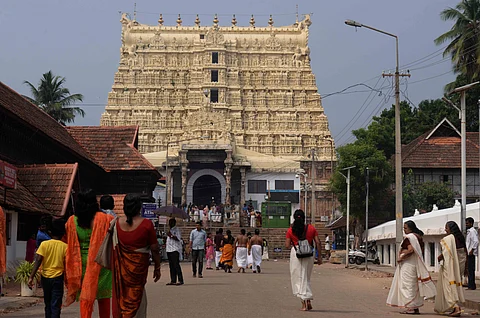

It is one of the great questions that continues to rage in Kerala – will the mysterious Vault B in Thiruvananthapuram’s Sree Padmanabhaswamy Temple be opened? And of course, the inevitably corollary – Will the world at large get to know just what is inside this secret chamber?
Feverish speculation regarding the contents of Vault B has gone on ever since five other vaults in the temple were opened, revealing massive amounts of treasure in the form of gold, silver, diamonds and other precious stones, cast into ornaments, idols, coins, vessels and so on.
While unofficial estimates peg the wealth of the temple at around Rs 1,00,000 crore (taking only the intrinsic but not the antique value of the treasure), veteran journalist and columnist Malayinkil Gopalakrishnan – an authority on Travancore history – says that there are no historical or contemporary documents on exactly what is contained within Vault B.
It’s not as if the temple’s history has gone completely undocumented. On the contrary, says Gopalakrishnan, from the 14th to the 17th century, the day-to-day history of the temple was meticulously recorded on palm leaves. Called the Mathilakam Documents, there are 3.5 lakh churunakal (bundles) of documents written using traditional writing materials like Thali Ola and Narayam.
“Hundreds of thousands of Mathilakam documents written on palm leaves are under the custody of the State Archives and are an invaluable treasure for students of history,” says dutchinkerala.com, the website on Kerala history run by Gopalakrishnan. The oldest document among these comes from all the way back in 1336 (Year 511 in the Malayalam calendar).
“Written in ancient languages like Malayanma and mixtures of Malayalam and Tamil, this perhaps is the only (set of) documents throwing light on the socio-political affairs related to the temple. As per these documents the temple was immensely rich even since the 14th century. Besides vast stretches of landed property, the temple also used to receive much wealth, gold, elephants, etc, made as offerings or penalties by devotees,” narrates the website.
Despite this rich historical resource, however, the crucial questions being asked about the temple’s wealth remain unanswered. While there are invaluable details about the construction of the temple and its daily affairs, says Gopalakrishnan, “Even in the Mathilakam documents that have been interpreted till date, there are no details regarding the valuables in the vaults, or about their construction, or even how many chambers there are in the vault.”
While the specific contents of the temple’s final unopened vault are unknown, Gopalakrishnan says that there are historical theories on how massive amounts of treasure reached the temple. “Much of it could be formed from offerings, penalties or donations from kings of not just Travancore but other states as well,” he writes on his website.
The site posits that much of the wealth could have been donated by King Marthanda Varma. “(He had) amassed huge wealth from his campaigns and conquests of other principalities neighbouring Travancore during the 18th century. He had conquered many wealthy kingdoms which had a flourishing trade of pepper and spices with the Portuguese, Dutch, Danes and English,” it narrates.
Other possible sources for some of the temple’s wealth are the rich rulers and landlords of Malabar who sought asylum in Travancore when Tipu Sultan forayed into the region.
Indeed, says Gopalakrishnan, “Even the attack of Tipu Sultan on Kerala in 1789 could be viewed not only through a communal lens, but also with an eye on the wealth of the temple.”
In the debate that has raged between the Supreme Court, the Travancore royal family that managed the temple and the Kerala government, the royal family has encouraged the belief that Vault B has never been opened in its recent history. They also encourage the belief in a disaster awaiting the temple if the vault should be opened.
However, the Comptroller and Auditor General Vinod Rai had told the SC in his report that the vault had been opened once in 1990 and twice in 2002. The royal family, however, has claimed that on these occasions, only the ante-room of the vault was opened, while the main chamber of the vault went untouched.
Rai’s report had also said that the records maintained on the weight and purity of the temple's gold and silver valuables were incomplete, and there was no proper oversight over the custody and use of precious articles and slack maintenance of the temple asset's register.
With such conflicting information available on Vault B and the status of the temple’s wealth, says Gopalakrishnan, it is better that the vault be opened and its contents properly catalogued to prevent theft and loss of assets.
With the Supreme Court saying on July 4 that it cannot continue to monitor the administration of the temple, but still examining the question of opening Vault B, Gopalakrishnan suggests that models for the management of the temple already exist. Following the Guruvayoor temple, he suggests, the administration can be handed over to a trust that includes members of the royal family.
As to the immense treasure uncovered in the temple’s vaults, Gopalakrishnan suggests that the Tirumala Tirupati temple’s recent example of depositing its gold with a national bank. The TTD last year deposited 1,311kg of gold bars with Punjab National Bank under the Gold Monetisation scheme, at an interest rate of 1.75% per annum. “The interest received could be used to run charitable healthcare and educational institutions,” Gopalakrishnan suggests.
Edited : by Rakesh Mehar
Pics: Sreekesh Raveendran Nair